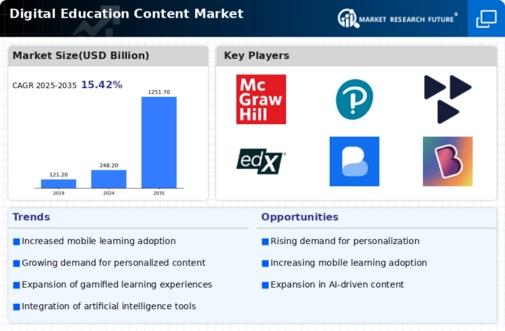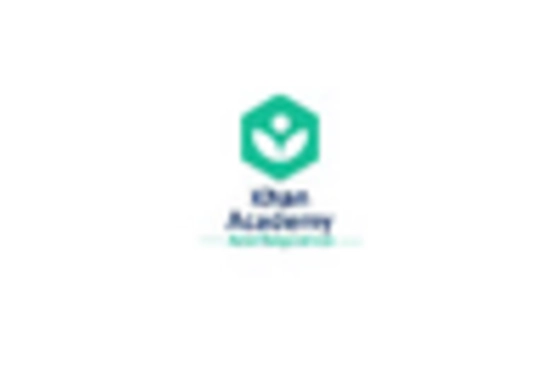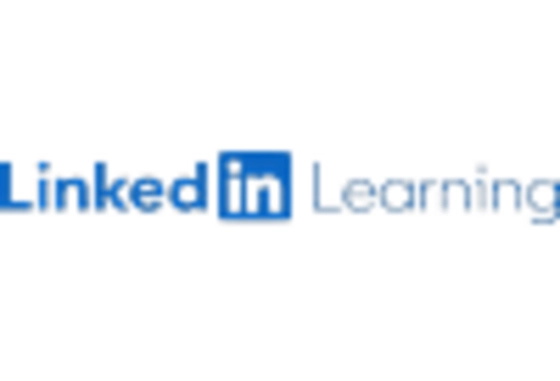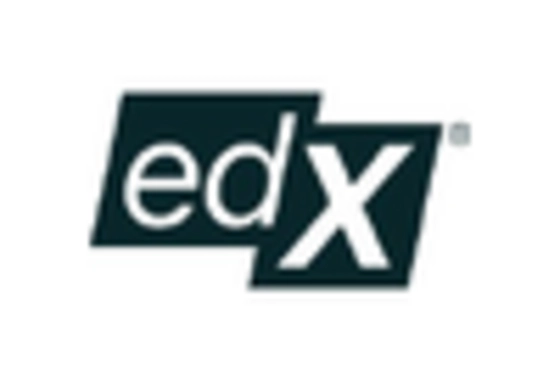Focus on Skill-Based Learning
The emphasis on skill-based learning is reshaping the Digital Education Content Market. Employers are increasingly prioritizing practical skills over traditional academic qualifications, prompting educational providers to adapt their content accordingly. This shift is reflected in the growing popularity of vocational training programs and online courses that focus on specific skill sets. As a result, the Digital Education Content Market is witnessing a rise in demand for content that is not only informative but also applicable in real-world scenarios. This trend indicates a potential transformation in how educational content is developed and delivered, aligning more closely with the needs of the labor market.
Increased Investment in EdTech
Investment in educational technology, or EdTech, is significantly influencing the Digital Education Content Market. Venture capital funding for EdTech startups has seen a remarkable increase, with billions of dollars being allocated to innovative educational solutions. This influx of capital is facilitating the development of cutting-edge digital content and platforms that cater to diverse educational needs. As educational institutions and businesses recognize the value of technology in enhancing learning outcomes, the demand for high-quality digital education content is likely to rise. This trend suggests a robust future for the Digital Education Content Market, as more stakeholders seek to leverage technology to improve educational delivery and accessibility.
Rising Demand for Online Learning
The Digital Education Content Market is experiencing a notable surge in demand for online learning solutions. This trend is driven by the increasing acceptance of digital platforms for education, as more learners seek flexible and accessible learning options. According to recent data, the online education sector is projected to grow at a compound annual growth rate of approximately 20 percent over the next five years. This growth is indicative of a broader shift towards digital learning environments, where traditional educational methods are being supplemented or replaced by innovative digital content. As educational institutions and organizations adapt to this demand, the Digital Education Content Market is likely to expand, offering a diverse range of learning materials and resources tailored to various learning styles.
Global Shift Towards Lifelong Learning
The concept of lifelong learning is gaining traction, thereby impacting the Digital Education Content Market. As individuals increasingly recognize the importance of continuous skill development in a rapidly changing job market, there is a growing demand for digital education resources that facilitate ongoing learning. This shift is evident in the rising popularity of online courses, webinars, and micro-credentialing programs, which provide learners with the flexibility to acquire new skills at their own pace. Consequently, the Digital Education Content Market is likely to see an expansion in offerings that cater to adult learners and professionals seeking to enhance their qualifications and competencies.
Technological Advancements in Education
Technological advancements are playing a pivotal role in shaping the Digital Education Content Market. The integration of artificial intelligence, machine learning, and augmented reality into educational content is enhancing the learning experience. These technologies enable personalized learning pathways, allowing learners to engage with content that is tailored to their individual needs and preferences. For instance, AI-driven platforms can analyze student performance and adapt content accordingly, fostering a more effective learning environment. As these technologies continue to evolve, they are expected to drive further innovation within the Digital Education Content Market, potentially leading to the development of more immersive and interactive educational experiences.

















Leave a Comment